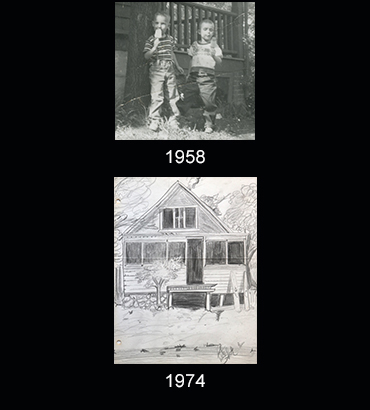 |
Peter's story:
As a child born in the early 1950s, Peter's only real interests were focused on fudge bars and keeping up with his older brother. He didn't think much about art except for what he could scribble on the walls of their two-flat, or make a mess with a newly invented product that involved colored dough. As he grew as a child, he would draw stick figure scenarios on a sheet of paper that depicted army soldiers battling each other. These battles were influenced from the realistic violence depicted on the 1960's television series, "Combat" and his imagination.
Even though his mother had studied art at Northern Illinois University, Peter was not encouraged to pursue or develop his interest in art. Pure peer pressure kept him from taking art courses in elementary school and in high school. His social group did not perceive the arts as important or relevant. However, in high school, he did begin to develop his interest in art on his own. He kept a 3-ring binder of drawings and ideas that he enjoyed working on during study hall and other free time. Plus, he developed a very crude comic book that was a one-of-a-kind stapled manuscript. He would share this book with his friends to get a laugh. He held latent dreams that he may some day develop this book into an actual publication.
However, Peter's family did not have the means to help support these dreams. Like many young high school students, Peter worked part time at a fast-food restaurant. This allowed him to save money and help get his life in order. After graduation, the owners of that restaurant offered him an assistant manager position that paid very well for an 18 year old. He accepted, soon married his high school sweetheart, and then, together, they purchased a modest home in the community. During this time, the owners of the restaurant recognized his artistic talents and asked him to get involved with their advertising to create ads and illustrations for newspaper promotions.
This lit the fire for his passion to become an artist. He came to understand, though, that his talent would not develop without a proper education. His wife encouraged him to pursue a college education and, in 1975, they ended up in the metropolitan area of Chicago where Peter attended the Chicago Academy of Fine Arts (CAFA). |
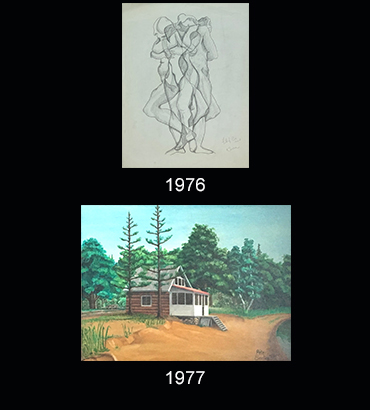 |
There were two reasons he chose the Academy; 1. a fellow high school student who was extremely talented had attended the school a few years earlier. And 2. Walt Disney had graduated from the Academy back in the early 1900s. The school did offer a fine arts curriculum, but it's reputation was noted for its commercial art education, including animation and cartooning. This was the combined major that Peter decided to pursue.
At CAFA, Peter blossomed. Even though he had never taken a serious art course before, he received straight A's his first year. They were the basic courses, but his hunger to learn, understand, and succeed pushed him to work much harder than he thought possible. This surprised even him.
CAFA was located in downtown Chicago only a few blocks from the Art Institute of Chicago. The students at CAFA were allowed free admittance to the Art Institute and Peter would take advantage of this benefit as much as possible. He and other students would take their sketch pads and sit and sketch renderings of famous works of art.
They would also walk around the city of Chicago and do life drawings, trying to capture the cityscape or candid scenarios of people having conversations, playing ball, or sitting with a loved one. These sketches were often crude, quickly rendered and then discarded. But the experience gave an artist the practice to develop their skills similar to how a musician repeatedly plays for hours to improve his rhythm and cadence.
Peter's wife, Mary, was not only patient with his pursuit of the arts, but extremely encouraging. During his education, she worked to support the family, including their young child, Erik. Peter wonders to this day, "How could she have worked that hard to help me pursue a dream like this?" It made quite an impression on cementing his family relationship and realizing that he had found his soul mate.
Through hard work and perseverance, they made it through the college years and Peter was able to land an entry-level position as a production artist in the commercial art field. It was not animation, but he did occasionally use his cartooning skills for spot illustrations. Pay was modest but it gave him a foothold into his career. |
 |
Even though Peter was focused to succeed as a commercial artist, he admired and respected the fine arts. He found ways to participate in that field as often as possible. Occasionally he would copy an artists work to learn their style and technique.
To develop his own approach, though, he had a subject that would allow his passion to expand. Peter's grandfather had built a primitive log cabin north of Chicago in 1938. This was a summer retreat for all of the family, including Peter's aunts, uncles and cousins. Growing up with this wonderful, youthful experience imprinted an important visual within him. And even before Peter went to CAFA, he wanted to capture the essence of what his cabin experiences had been. He often tried to draw the cabin, but without the proper education, his attempts were less than satisfying.
College allowed him to use the cabin as a powerful learning device to develop technique and understanding for creating imagery on the 2-dimensional plane. He was motivated to capture the cabin's image as often as he could and did a few class projects with it as the subject.
Also, during this time, two of his six siblings announced wedding engagements. Peter felt this was a perfect opportunity to create a personalized gift that depicted the cabin for each sibling. He would spend weeks working on each drawing or painting and then gave them the finished framed piece as a gift.
It was a valued gift and allowed Peter to stay involved in the fine arts, albeit in a relative manner.
As a production artist for the commercial arts, he learned how to produce graphics for the mechanical reproduction of commercial art. This was prior to the desktop computer age. Typography, film stripping, photostats and color systems were all standards in this growing industry. It took knowledge and skill to correctly design and assemble the camera-ready graphics prior to going to print.
Peter quickly caught on and in just a few years was able to graduate to more creative tasks and responsibilities. |
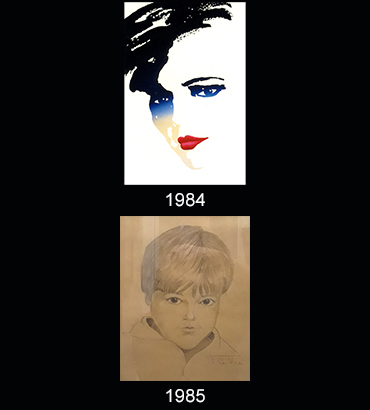 |
By 1981 he had become an art director for a prominent west suburban design studio located in Lombard, IL. His firm worked for locally owned and national corporations. His contributions helped grow the studio and they gained momentum with clients like McDonald's, Rockwell International, Spiegel and others.
In 1986 he advanced his career as vice-president and creative director. He oversaw a staff of art directors and artists in the conceptual through production phase of each creative effort.
Much of his personal time was limited, but he stayed devoted to his family and shared the responsibilities to help their son grow into a young man. Then, if he had a few minutes, he made time to pursue his passion of oil painting and the creativity of fine art. Many of his six siblings were sporadically announcing their wedding plans and Peter continued to create and gift each one with a unique rendering of their grandfather's cabin.
During this time, he was also inspired to create a series of 'high fashion' illustrations of women's faces that he named "Expressions." This was the first time he explored a genre which he now calls "Stylized Synergy." He combined a seemingly spontaneous brush stroke that was painted via airbrush, with 3-dimensionally rendered lips of a fashion model. Each rendering of a woman's face depicted a different mood or expression.
He was invited to exhibit these originals in downtown Chicago and was successful in locally marketing reprints during the late 1980s. However, he was unprepared to change his career path at the time and was unable get proper backing to market these prints nationally.
By 1991, he had the opportunity to get involved with the gift product industry. Instead of entering the management arena as he was qualified, he chose to stay on the drawing board and devote 100% of his office time to developing creative products and graphics for packaging and promotions. He simply put his head down and worked on each creative project to be as unique and creative as possible. |
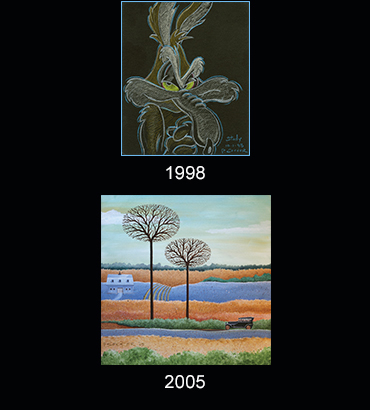 |
He was responsible for creating products and packaging for licensed corporations including; Disney, Coca-Cola, Mattel, Warner Brothers, the Beatles and more.
Graphics computers and software stormed the industry during the 1990s. Every commercial artist was forced in some way to change his technique of work to adhere to the rules and regulations of this new tool and the ever changing software. This would not have been such a complication if the desktop computer industry was then as it is now. However, computers in the 1990s could not handle the degree of memory required to render high resolution graphics. It took years to standardize these systems to an accepted level.
Creativity, however, was still in demand. The computer only made it easier and faster. As Peter adjusted to these new algorithms, it proved to improve the speed and quality of commercial art and production. These new skills helped with his ability to offer creative ideas to his industry and he excelled to the point of starting his own design firm, Thomas Sebastian Companies, in 2006.
He landed enough clients to make a good living, but with the help of the computer, he also found more time to devote to oil painting.
After the turn of the century, he continued his cabin series and painted original compositions as wedding gifts for his nephew and niece. He also had time to expand his subject matter and experiment with ideas that he custom painted for his wife.
He did many studies including video instructions with established artists.
He wasn't a huge fan of using another artist's technique. However, creating these studies helped him loosen up with his own approach to painting. It taught him about color mixing, layering and many correct ways to approach a painting. |
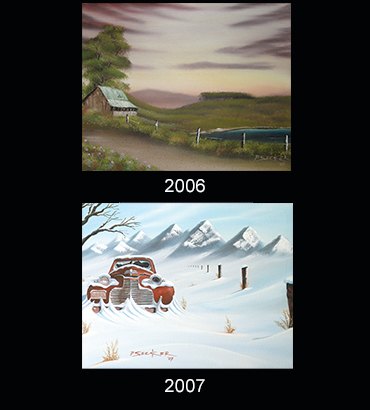 |
In 2007, Peter got the idea to paint a rusty old car incorporating some of the techniques he had learned. On the car's license plate, he included the tag letters; 4GOTTEN. This was the beginning of his 'Forgotten' series. However, he did not begin his second in the series until the end of 2019.
Between 2007 and 2019 Peter kept busy with his design firm helping to promote other businesses in a multi-state region. Plus, as his business grew, the internet allowed the flexibility to work with companies around the nation and he had clients from coast-to-coast.
In 2018, Peter semi-retired from commercial art and began to express his creative freedom in a more prolific manner. When Covid-19 hit in 2020, he took advantage of the down-time and concentrated on his painting style and technique. He now feels that he has the freedom to work each idea in a style and technique that fits his message. He looks at each creative endeavor as an adventure that only he needs to enjoy. This allows his ideas to be expressed without apprehension and helps to explain the genre of "Stylized Synergy."
His motivation to paint always lies in the inspiration of an idea. The final image must express through design and technique a message that Peter wants to communicate. Whatever technique is used in the creation has been determined with the synergistic unity of how he thinks.
His most challenging works of art, thus far, are in the compositions and the styling of his 'Forgotten' series. He spends many months on each painting; researching, composing and rendering.
But his interests in other subjects and styles allow him to explore other avenues and genres each year also.
His annual goal is to produce paintings for twelve specific categories; 'Forgotten' series, 'Cabin' series, 'Unhappy Face' series, 'Cloud' series, 'Cars,' 'Drips, ''Birds,' 'Fun Fish,' 'Abstract,' 'Portraits,' 'Charity,' and 'Flawed But Not Forgotten.' |
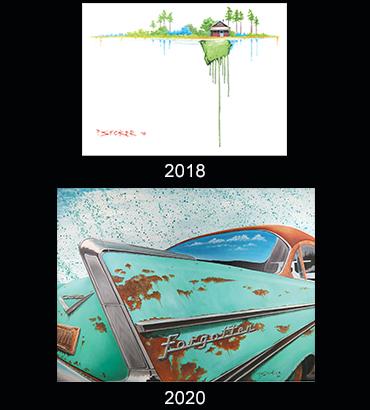 |
These are areas and ideas he feels worthwhile to explore and expand upon. However, he is never in short supply of a good idea and will always try to communicate that through his design and painting technique. He looks forward to producing unique works of art for many years to come.
His dream to publish a book came true in 2007 after his first grandchild was born. He wrote and illustrated a book named: "Frik & Frak from A to Z." Then, in 2012, another for his second grandchild, "Freeman Frog's 20 Number 1 Favorite Things." Since, he has also authored and illustrated books such as; "Loriel Meets the Candy Fairy," and "I Love You More Than..."
He is now a member of the Seacoast Artist Guild and the Waccamaw Arts Guild, both located in Myrtle Beach, South Carolina. In his first competitive showing at Seacoast, he won recognition for "forgotten-2" which he painted in 2020. In the Spring 2023 show he won BEST OF SHOW for his painting "ForGoT10-3" at the Seacoast gallery.
In 2024, he received an Honorable Mention for "Al & Martha's Legacy" (#32 in the cabin series) at the same gallery.
Click here for current show and exhibit information.
Peter's son, Erik, is a successful publisher, IT professional and proud father of two. You may view his published books at www.bourbonpenn.com.
Mary is still Peter's best friend, loving wife and partner. She continued her career and was able to return to college to receive her master's degree in business. She has her own business and continues to provide assistance to others as a public speaker's coach and also works as a semi-retired consultant.
Thank you for taking the time to read this story. We hope it allowed you to understand the person behind the images on this website. if you have interest in investing in Peter's art or have any other questions, please contact us for more information.
Also, you are invited to come back often to view recently completed works. |
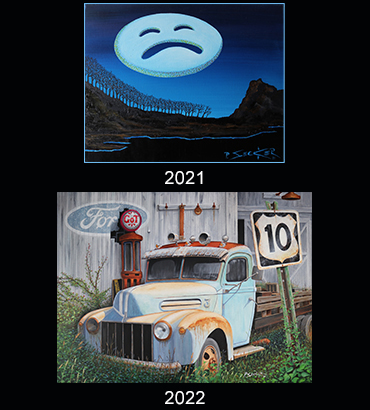 |
|
 |
|
|
|
|
|
| |
|
|
| |
|
|
|


